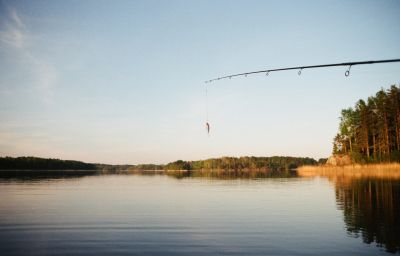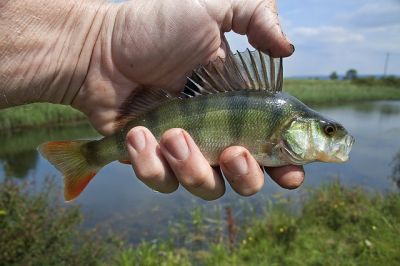In recent years, lure fishing for perch has exploded in popularity. The perch is now one of the most pursued fish in Europe. There are a few reasons for this.
1. Many fishing waters are now devoid of pike and therefor perch have become the apex predator.
2. The development of light lure tackle has led to some good sport.
All this means there is a record number of specimens being caught all the time and there has never been a better time to take up lure fishing for perch.
It’s no coincidence that I write this article in late October as autumn is prime time for perch fishing. Cooler temperatures, less sunlight and shorter days, all mean perch can employ their predatory assets to the max. This gives those of us lure fishing for perch the opportunity for some exceptional sport.
So what do you need to start lure fishing for perch?
What do I need to start lure fishing for perch?

The lure rod:
Lure fishing for perch requires a short, lightweight rod, which you can hold all day and stay mobile with. An important consideration is the sensitivity of your rod. You must be able to feel every bump of the lure on the rod tip.
A 6ft or 7ft carbon lure rod, with a casting rating of 5-15g, is ideal. Rods you could consider are:
The reel and line:
For perch fishing, you need about 150m of line on your reel. The best size of reel is between 500 and 2500. The higher the number, the more line you can put on there.
Reels you could look at are:
Perhaps the most important part of lure fishing for perch is your line. You must have a braided mainline. Braid has very little stretch compared to a monofilament line, and this delivers many advantages.
First, thin braids cast better, giving you a greater casting range than with mono.
Second, because of the lack of stretch and the fine diameter of braid, the lure reacts instantly to any movement of the rod. It is important to remember that you must have a braid with a breaking strain between 10lb-14lb to cope with repeated casting and striking.
Third, braid is more durable than mono and will last two to three years. It may cost slightly more than mono, but braid presents value for money in the long run.
The braid I use:

The Lures

You will need to pick up some soft plastic lures and a few bits of terminal tackle to rig them. There is a tremendous choice of lures and it’s tough to know where to start. I will list my favourite type of lures that I use and that should hopefully give you an idea of where to start. Please don’t feel you need to go with the same ones listed here. Part of the fun of lure fishing for perch is finding lures that work yourself.
A word of caution.. pike will take a small soft plastic lure so use wire lure traces to be on the safe side.
1. The Worm
Perch love worms. Therefore, it makes sense that it will also attract them to a lure that imitates one.

3. The Grub
This looks like a giant maggot, The Grub bait to mix things up or if you are getting very gentle hits. Retrieve straight or by jigging to make it hop.

4. The Twin Tail
Twin Tails offer a completely different action to a shad. Fish them with sharp jigs of the rod to bounce the lure along the bottom. Bites often come as the bait sinks. This means you should pay attention to how the lure feels as it is sinking so you know when something disrupts it.

5. The Shad
I use a 2/4″ traditional shad design and a jig head. Often a straight of varying pace will get a take and is one of the best ways to use them. Let the lure hit the bottom and then bring it back. A classic jigging technique will get bites too.
6. The Spinner
A good old spinner catches perch. People seem to have forgotten but when all else fails I put on a bronze Mepps 2/3 and more often than not it does the business.
Jig Heads
A jig head is an essential component of lure fishing for perch. It is essentially a weight with a hook built into it. The hook placed into the front of a soft plastic lure which is then carefully threaded through the lure until it protrudes at the top of the soft plastic.
The jig head makes sure the lure can sink, but it also gives it a casting weight. This results accurately placed casts next to any feature you expect could hold perch.
I use small jig heads weighing between 5g and 15g. They are light enough to ensure your lure hops nicely but are heavy enough for you to feel as they move up and down in the water. This allows you to feel the exact moment a perch seizes the lure and breaks the rhythm.

Finding Perch

In lure fishing for perch, watercraft is the key to success.
The first thing to do when lure fishing for perch is to search the water for signs of likely hotspots. You should look for anywhere that could give perch shelter and the confidence to hunt their prey. Equally important are areas that could be home to a baitfish. Areas you should consider are reed beds, overhanging trees, lily pads, walls or man-made objects this includes shopping trolleys, unfortunately. An excellent rig for fishing in areas of deep-cover is the Jika Rig, you can find out more about this excellent setup here.
Tease them out of hiding
Once you’ve found a holding area, cast a small lure and work the feature methodically, making sure you cover as much of it as possible. The idea here to work out exactly where the small perch is as they will always be up for hitting lure. If you get hits and catch a few smaller perch, then you can switch to a bigger lure and search out the specimen fish that will usually sit on the periphery. This is because big perch hangs back from the main shoal.
Its time to go fishing. Let us know if you have any questions or anything you feel could be added to this post. I truly hope you enjoy lure fishing for perch as much as I do. Best of luck and let us know how you get on in the comments below.
Interested in how to catch pike in Autumn? Check out ‘How to catch pike with lures in autumn’
Tight lines.







Pingback: The Best Perch Lures In 2019 (UK) | Pike & Zander
Pingback: KODEX Karp-Lokker KL40 Carryall Review | Pike & Zander
Pingback: Lure Fishing Techniques | Pike & Zander | Predator Angling Blog
Pingback: FishSpy Echo Pro Review - The Best Castable Sonar You Can Buy | Pike & Zander
Pingback: Fishing for Pike with Lures | A Complete Guide | Pikezander.co.uk
Great post, I’m fairly new to lure fishing so this has really helped me out! Thankyou
Pingback: Best Spinning Reels Under £100 (2020) | Pike & Zander | Predator Angling Blog
Pingback: The Ned Rig | Pike & Zander
Pingback: The Cheb Rig - A Beginners Guide | Pike & Zander